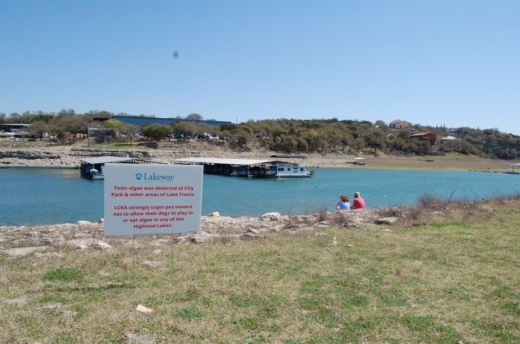Blue-green algae samples collected from the Highland Lakes chain have tested positive for toxins that can be fatal to dogs, according to a March 24 update from the Lower Colorado River Authority.
LCRA—the nonprofit utility agency in charge of the Highland Lakes chain—collected algae samples March 16 and 17 from five lakes.Samples obtained from Inks Lake, Lake Marble Falls and Lake Travis tested positive for cyanotoxins, which are emitted by harmful blue-green algae—an organic material more accurately referred to as cyanobacteria.
Low concentrations of cyanotoxin were found near the shoreline and boat ramp at Inks Lake State Park as well as the Cottonwood Shores boat ramp in Lake Marble Falls.
While the algae samples tested positive for the toxins, LCRA said samples taken from the surrounding water source did not.
The level of cyanotoxins detected in Inks Lake and Lake Marble Falls was significantly lower than samples taken downstream in the Hudson Bend or Travis Landing area of Lake Travis.
The presence of blue-green algae was first reported in the Hudson Bend region Feb. 26 after LCRA received notice that at least four dogs became ill after swimming in the area.
In March, LCRA collected both water and algae samples around Lake Travis. Algae samples collected from 10 sites around the lake tested positive for cyanotoxins, according to a March 12 news release from LCRA.
Those sites included Arkansas Bend Park, Bob Wentz Park, Comanche Point, Cypress Creek Park, Lakeway City Park, Mansfield Dam Park, Pace Bend Park, Sandy Creek Park, Tom Hughes Park and Travis Landing.
That release also confirmed that a total of two dogs had died and five others became ill after swimming in the Hudson Bend, Travis Landing and Comanche Point regions of the lake.
Notably, test results obtained March 23 indicated lower levels of cyanotoxins near Travis Landing and Hudson Bend than what was detected in the two previous tests.
Still, cyanotoxins, even in low concentrations, can be fatal when the blue-green algae or water is ingested by dogs, according to LCRA. When ingested, cyanotoxins can cause vomiting, excessive drooling and respiratory paralysis, among other symptoms.
“We encourage people in the strongest terms possible not to let dogs play near algae in the lakes. Our tests show what was present at the specific site we tested on the day we took the samples, but conditions can change,” said John Hofmann, LCRA’s executive vice president of water, in the release.
Blue-green algae are common in Texas lakes, Hofmann said, adding that it can be difficult to predict if or when that algae will begin to produce toxins.





